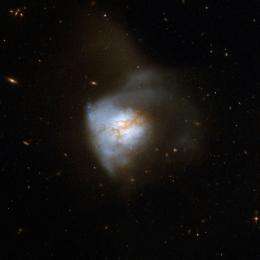Intense Star Formation in the Early Universe

(PhysOrg.com) -- Distant galaxies are not only far away in space. Because it takes time for their light to reach us, they are also very far away in time -- snapshots from the distant past.
The most distant galaxies known are seen as they were when the universe was less than a billion years old, and their light has been traveling towards us for over twelve billion years. Astronomers are able to study these remote, ancient galaxies because they are fantastically bright, some of them hundreds of times more luminous than our Milky Way. Astronomers want to understand them because somehow these primeval galaxies develop into modern galaxies, like our own or others in our cosmic neighborhood. One outstanding question exists: what makes these galaxies so bright?
CfA astronomers Steve Longmore, Ray Blundell, Mark Gurwell, and Dave Wilner, together with eighteen of their colleagues, used the Submillimeter Array (SMA) and several other telescopes to study a luminous galaxy whose light has been traveling towards us for ten billion years. Unlike most other known, bright, but remote galaxies, this one is fortuitously situated directly behind (as seen from earth) a much closer cluster of galaxies whose gravity acts like a lens to re-image the light. That coincidence, combined with the SMA's unique ability to see very fine spatial details at submillimeter wavelengths, allowed the scientists to measure individual clouds of gas and dust in the far-away galaxy.
Writing in the latest issue of the journal Nature, the team reports that these clumps are similar to star-forming regions in the Milky Way, except larger and much more luminous. From these and other characteristics of the clumps, the scientists conclude that vigorous star-formation is underway in this galaxy with underlying physical processes that are similar to those in normal galaxies, just much more intense. The possible reasons for such extreme activity are less clear, but the authors suggest that a galaxy collision, such as is commonly seen in the local universe, can stimulate the production of these large clumps.
The new paper is significant both because it clearly determines the nature of the huge luminosities in this far-away galaxy, and because it implies that current recipes for modeling star formation can be applied to these extreme cases.
Provided by Harvard-Smithsonian Center for Astrophysics



















